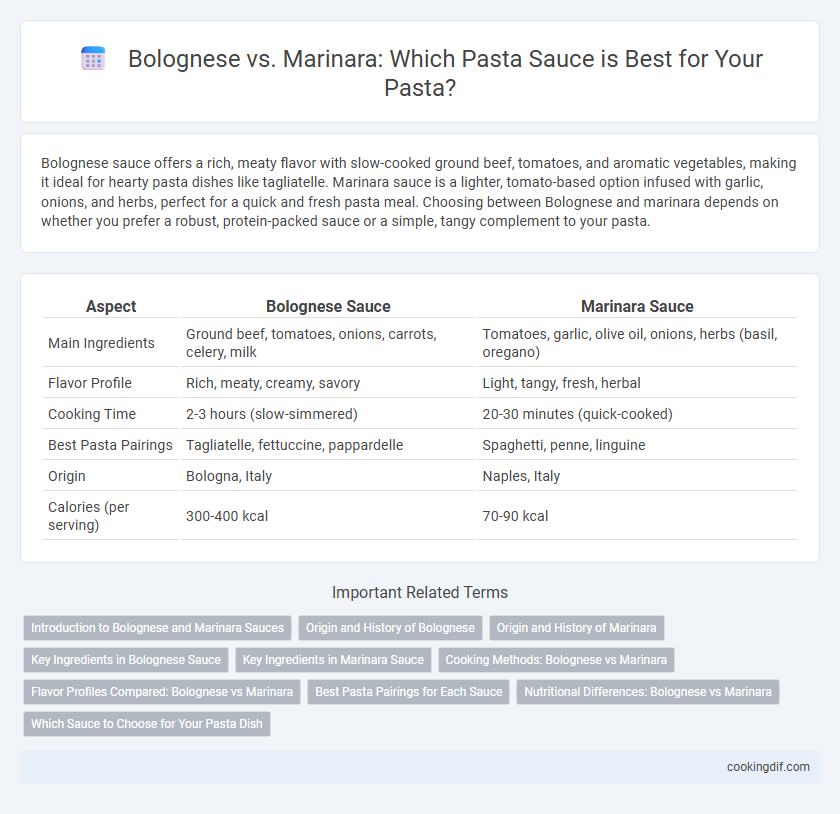Bolognese sauce offers a rich, meaty flavor with slow-cooked ground beef, tomatoes, and aromatic vegetables, making it ideal for hearty pasta dishes like tagliatelle. Marinara sauce is a lighter, tomato-based option infused with garlic, onions, and herbs, perfect for a quick and fresh pasta meal. Choosing between Bolognese and marinara depends on whether you prefer a robust, protein-packed sauce or a simple, tangy complement to your pasta.
Table of Comparison
| Aspect | Bolognese Sauce | Marinara Sauce |
|---|---|---|
| Main Ingredients | Ground beef, tomatoes, onions, carrots, celery, milk | Tomatoes, garlic, olive oil, onions, herbs (basil, oregano) |
| Flavor Profile | Rich, meaty, creamy, savory | Light, tangy, fresh, herbal |
| Cooking Time | 2-3 hours (slow-simmered) | 20-30 minutes (quick-cooked) |
| Best Pasta Pairings | Tagliatelle, fettuccine, pappardelle | Spaghetti, penne, linguine |
| Origin | Bologna, Italy | Naples, Italy |
| Calories (per serving) | 300-400 kcal | 70-90 kcal |
Introduction to Bolognese and Marinara Sauces
Bolognese sauce originates from Bologna, Italy, and features a rich blend of ground beef, tomatoes, onions, carrots, and celery, simmered slowly to develop deep, savory flavors ideal for thicker pasta like tagliatelle. Marinara sauce is a classic Italian tomato-based sauce made with garlic, tomatoes, herbs, and olive oil, offering a lighter and tangier complement to pasta varieties such as spaghetti or penne. Both sauces reflect regional Italian culinary traditions, with Bolognese delivering a hearty meat-based profile and marinara emphasizing fresh, vibrant tomato essence.
Origin and History of Bolognese
Bolognese sauce, originating from Bologna in the Emilia-Romagna region of Italy, dates back to the late 18th century and was traditionally a meat-based ragu made with finely chopped beef, pancetta, and soffritto slowly simmered with tomato and wine. Unlike marinara, a simple tomato-based sauce with garlic and herbs from Southern Italy, Bolognese represents a hearty, slow-cooked culinary tradition meant to complement thick, flat pasta like tagliatelle. The authenticity of Bolognese is protected in Italy, reflecting deeply rooted regional cooking methods distinct from the more universally adapted marinara sauce.
Origin and History of Marinara
Marinara sauce originated in Naples, Italy, during the 16th century as a simple, tomato-based sauce made for sailors ("marinai") using tomatoes, garlic, olive oil, and basil. Its history reflects the introduction of tomatoes to Europe from the Americas after the Columbian exchange in the late 15th century. Marinara remains a traditional Southern Italian sauce, distinct from the rich meat-based Bolognese of Emilia-Romagna, emphasizing fresh, vibrant ingredients in a quick preparation.
Key Ingredients in Bolognese Sauce
Bolognese sauce features key ingredients such as ground beef or pork, onions, carrots, celery, tomato paste, and a splash of red wine, creating a rich and hearty flavor. Slow simmering with milk or cream enhances its creamy texture, setting it apart from the lighter, tomato-based marinara sauce. The depth of meat and vegetable flavors in Bolognese makes it a robust choice for thicker pasta varieties like tagliatelle or pappardelle.
Key Ingredients in Marinara Sauce
Marinara sauce is characterized by its simple, fresh ingredients including ripe tomatoes, garlic, olive oil, and fresh basil, which create a light, vibrant flavor profile. Unlike Bolognese, which relies on ground meat and a slow-cooked base, marinara emphasizes the natural sweetness and acidity of tomatoes with subtle herbaceous notes. Its minimalistic ingredient list makes marinara sauce a popular choice for lighter pasta dishes and vegetarian options.
Cooking Methods: Bolognese vs Marinara
Bolognese sauce requires slow simmering of ground meat with tomatoes, onions, carrots, celery, and wine for several hours to develop a rich, complex flavor and thick consistency. Marinara sauce is prepared by quickly sauteing garlic and onions, then simmering tomatoes and herbs for a shorter period, resulting in a fresh, light, and vibrant sauce. The extended cooking time in Bolognese tenderizes meat and melds flavors, while marinara's brief cooking preserves the bright acidity and freshness of the tomatoes.
Flavor Profiles Compared: Bolognese vs Marinara
Bolognese sauce offers a rich, savory flavor profile characterized by slow-cooked ground meat, tomatoes, garlic, and aromatic herbs, resulting in a hearty and umami-packed taste ideal for thicker pasta like tagliatelle. Marinara sauce features a bright, tangy tomato base with garlic, olive oil, and fresh basil, delivering a lighter, fresher flavor profile perfect for spaghetti or penne. The contrast between Bolognese's depth and meatiness and marinara's vibrant simplicity defines their distinct culinary uses and pairings.
Best Pasta Pairings for Each Sauce
Bolognese sauce, rich with ground meat, tomatoes, and aromatic vegetables, pairs best with wide, flat pasta like tagliatelle or pappardelle that can hold its hearty texture and robust flavors. Marinara sauce, a lighter tomato-based sauce with garlic, onions, and herbs, complements thinner pastas such as spaghetti or linguine, allowing the fresh, vibrant taste to shine through. Choosing the right pasta for each sauce enhances the overall dish by balancing texture and flavor profiles effectively.
Nutritional Differences: Bolognese vs Marinara
Bolognese sauce typically contains ground beef, tomatoes, and cream, resulting in a higher protein and fat content compared to marinara, which is primarily tomato-based and lower in calories and fat. Marinara sauce offers more vitamins from fresh tomatoes and herbs, including antioxidants like lycopene and vitamin C. Choosing between Bolognese and marinara depends on dietary preferences, with Bolognese providing more iron and protein, while marinara supports lower calorie intake and increased antioxidant benefits.
Which Sauce to Choose for Your Pasta Dish
Choosing between Bolognese and marinara depends on the desired flavor profile and texture. Bolognese offers a rich, meaty sauce made from ground beef, tomatoes, and aromatic vegetables, ideal for hearty pasta like tagliatelle or pappardelle. Marinara presents a lighter, tomato-based sauce with garlic and herbs, perfect for delicate pastas such as spaghetti or penne seeking a fresh, tangy taste.
Bolognese vs marinara for pasta sauce Infographic

 cookingdif.com
cookingdif.com